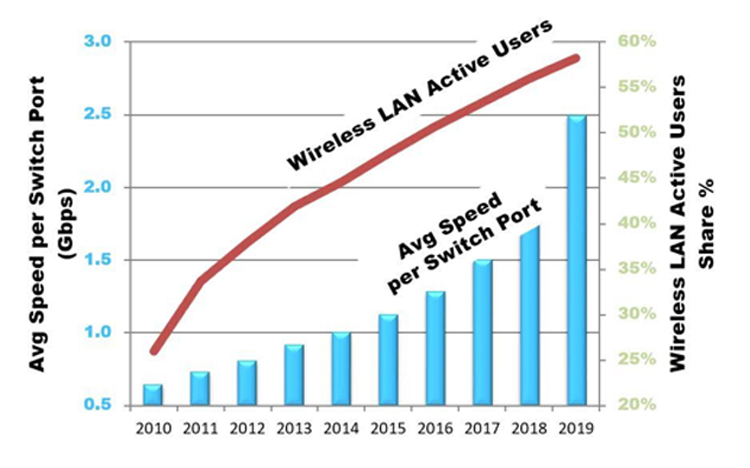Wires in creating a wireless network
2017-07-24
What comes to the mind when you think “wireless”? Devices that magically connect to your network with no cables or wires in sight … right?
Laptops in the workplace were the first real foray into enterprise wireless networks, further smartphones, hand – held devices and smart watches have entered the picture and then the IP-enabled devices that make up the Internet of Things (IoT). All of these connected devices increase strain on your network.
How connected devices are used can also give enterprise wireless networks a run for their money. Consumers stream high-definition video, share large photos and video files, and constantly engage with social media. They want to connect, no matter where they are or what type of building they’re in: a hotel guest who wants to sit in the onsite restaurant while catching up on work, a college student who wants to watch a recorded classroom lecture outside or an employee who wants to take a tablet to the top-floor lounge to do some brainstorming.
And the demand is only going to continue to increase. By 2020, Cybersecurity Ventures predicts that Wi-Fi and mobile devices will make up more than 60% of IP traffic. By 2025, that number will reach nearly 80%. And according to Dell’Oro, the number of wireless LAN active users is outpacing wired LAN users.

How Cable is Involved
Enterprise wireless networks involve more than connected devices and people (although those factors are what most people think of first). What else is involved in creating a wireless network? Wires! (Ethernet cables, specifically.) In order for an enterprise wireless network to function, for example, each wireless access point (WAP) must connect to a network switch via a cable.
As more WAPs are installed to improve wireless coverage, more cabling is required in pathways to support increased network capacity. If the cabling infrastructure that supports enterprise wireless networks isn’t functioning correctly, it can cause Wi-Fi to be spotty, connect/disconnect unexpectedly or to go down altogether.
Cable infrastructure plays a crucial role in successful enterprise wireless network deployment. If the chosen cable and connectivity aren’t sufficient or aren’t designed to meet the needs of the devices and people that connect to it, end-users will suffer from unplanned downtime, lost productivity and even lost revenue. To put it simply: Your enterprise wireless network is only as good as the cabling infrastructure that lies beneath. More users and devices on a wireless network eventually lead to more cable infrastructure upgrades to accommodate increased traffic demands.
Cable Type Matters
When selecting cabling and connectivity to support your enterprise wireless network, the following factors should be taken into consideration:
Data rate: What data rate can the cable support?
Current capacity and power delivery: Can the cable support the appropriate type of Power over Ethernet (PoE)?
Simple connections: Can the cable connect directly to a WAP without any other connection points in between for simplicity?
Heat tolerance: Can the cable maintain performance despite higher temperatures that come as a result of more power being transmitted to support higher-consuming devices?
TIA TSB-162-A provides guidance regarding the cable types that best support the WAPs making up an enterprise wireless network. The minimum recommended cabling is Category 6A (or OM3 for fiber).
Category 6A cabling offers full multi-gigabit implementation and higher cable uplink speeds and can transmit higher power wattage. Some Category 6A cables even have enough insertion loss margin to continue the same levels of performance despite the generation of extra heat. It can also support data rates of 10GBASE-T, ensuring a future-proof application.
Chandrashekar G - CDCP
National Technical Manager
Belden India & SAARC
See What’s Next in Tech With the Fast Forward Newsletter
Tweets From @varindiamag
Nothing to see here - yet
When they Tweet, their Tweets will show up here.





























